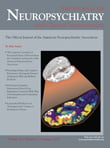Hemichorea-hemiballismus is a rare movement disorder which features involuntary movements of the limbs due to basal ganglia stroke being confined to the one side of the body.
1 Studies examining glucose metabolic rates or blood flow changes in regional brain areas have found that basal ganglia disorders are associated with decreased activity in the cortical regions.
2Topiramate is a broad-spectrum anticonvulsant. In addition to its therapeutic effect by vascular hemichorea-hemiballismus, topiramate was recently shown to be effective in reducing depressive symptoms in acute bipolar depression.
3Case Report
The patient, a 61-year-old man, experienced abrupt, involuntary movements of his left arm and left leg after he developed a right-sided stroke due to a basal ganglia infarction 6 months prior. In addition to these symptoms, he had developed in recent months a depressive mood; he felt sad, guilty, and lost practically all interest in doing things. The patient retreated from daily work activities and had difficulties with concentration and memory. He also described severe physical fatigue and moderate insomnia.
On psychiatric examination he was cooperative, alert, and fully oriented. He displayed a depressed mood state. His movements were slowed with signs of hypoactivity. During the examination, the patient cried and described morbid thoughts of death. The speech comprised simple vocabulary, then slowed and was spoken in a moderate depressive voice. It was sometimes interrupted by word-finding difficulties. The patient scored 34 on baseline HAMD.
A magnetic resonance imaging scan of the brain performed on the admission day showed a chronic lacunar infarct on the right lentiform nucleus on T2-weighted images correlating with the previous stroke 6 months prior. FDG-PET on admission day showed moderate to severe reduced glucose uptake right temporal cortex. Other cortical regions were found to be normal.
We started the patient on a regimen of topamirate 25 mg daily, increasing to 50 mg twice daily over a 2-week period. The optimum hemichorea control occurred when he was taking 50 mg of TPM twice daily after 2 weeks. A significant improvement of the depressive symptoms occurred, according to HAMD score, after 9 weeks of treatment. Interestingly, a PET follow-up after 9 weeks of topamirate treatment revealed more than a 70% (significant) increase in the right temporal area. In our study, the improvement of depressive symptoms seemed to be correlated with the normalized temporal metabolism after 9 weeks of treatment.
This was suggested by previous studies
4,
5 which claimed that recovery from depression after antidepressive treatment was associated with a decrease of glucose metabolism in the limbic system and an increase in neocortical areas. Interestingly, this is the reverse pattern of normal mood regulation by which with depressive mood state, increases in limbic-paralimbic blood flow, and decreases in neocortical regions were identified.
6In addition to suggesting a functional interaction between the cortex and limbic system, our findings support that the integrity of pathways linking the cortex and the basal ganglia may be integral to the normal regulation of mood.

